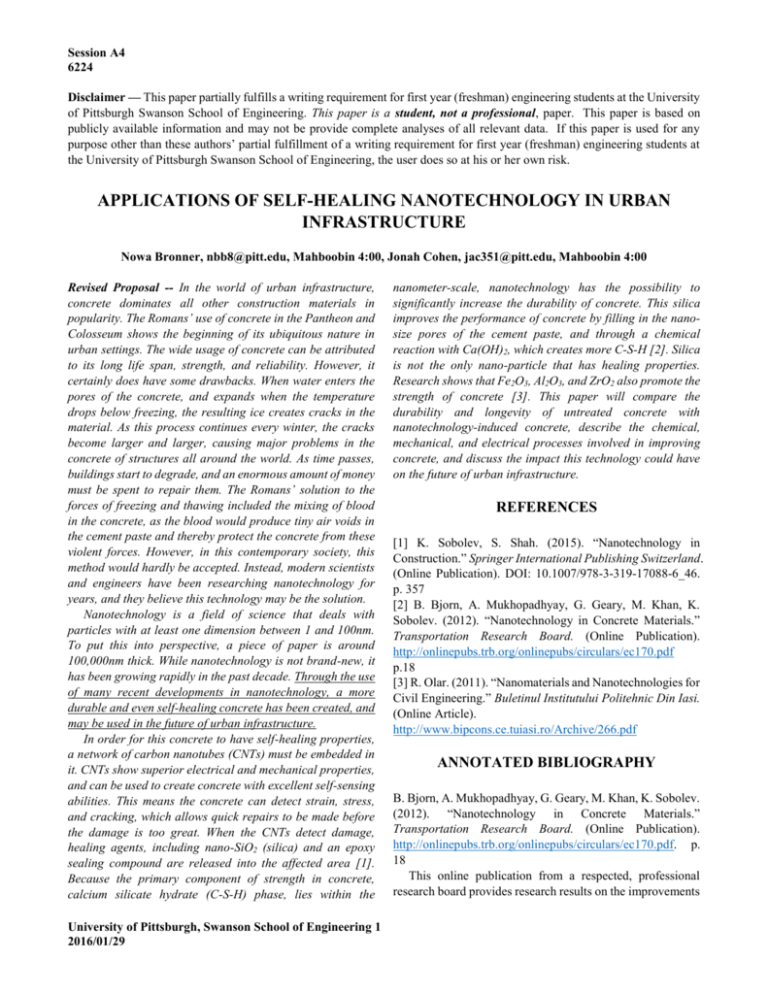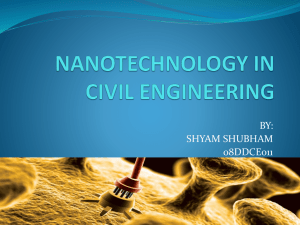applications of self-healing nanotechnology in urban infrastructure
advertisement

Session A4 6224 Disclaimer — This paper partially fulfills a writing requirement for first year (freshman) engineering students at the University of Pittsburgh Swanson School of Engineering. This paper is a student, not a professional, paper. This paper is based on publicly available information and may not be provide complete analyses of all relevant data. If this paper is used for any purpose other than these authors’ partial fulfillment of a writing requirement for first year (freshman) engineering students at the University of Pittsburgh Swanson School of Engineering, the user does so at his or her own risk. APPLICATIONS OF SELF-HEALING NANOTECHNOLOGY IN URBAN INFRASTRUCTURE Nowa Bronner, nbb8@pitt.edu, Mahboobin 4:00, Jonah Cohen, jac351@pitt.edu, Mahboobin 4:00 Revised Proposal -- In the world of urban infrastructure, concrete dominates all other construction materials in popularity. The Romans’ use of concrete in the Pantheon and Colosseum shows the beginning of its ubiquitous nature in urban settings. The wide usage of concrete can be attributed to its long life span, strength, and reliability. However, it certainly does have some drawbacks. When water enters the pores of the concrete, and expands when the temperature drops below freezing, the resulting ice creates cracks in the material. As this process continues every winter, the cracks become larger and larger, causing major problems in the concrete of structures all around the world. As time passes, buildings start to degrade, and an enormous amount of money must be spent to repair them. The Romans’ solution to the forces of freezing and thawing included the mixing of blood in the concrete, as the blood would produce tiny air voids in the cement paste and thereby protect the concrete from these violent forces. However, in this contemporary society, this method would hardly be accepted. Instead, modern scientists and engineers have been researching nanotechnology for years, and they believe this technology may be the solution. Nanotechnology is a field of science that deals with particles with at least one dimension between 1 and 100nm. To put this into perspective, a piece of paper is around 100,000nm thick. While nanotechnology is not brand-new, it has been growing rapidly in the past decade. Through the use of many recent developments in nanotechnology, a more durable and even self-healing concrete has been created, and may be used in the future of urban infrastructure. In order for this concrete to have self-healing properties, a network of carbon nanotubes (CNTs) must be embedded in it. CNTs show superior electrical and mechanical properties, and can be used to create concrete with excellent self-sensing abilities. This means the concrete can detect strain, stress, and cracking, which allows quick repairs to be made before the damage is too great. When the CNTs detect damage, healing agents, including nano-SiO2 (silica) and an epoxy sealing compound are released into the affected area [1]. Because the primary component of strength in concrete, calcium silicate hydrate (C-S-H) phase, lies within the University of Pittsburgh, Swanson School of Engineering 1 2016/01/29 nanometer-scale, nanotechnology has the possibility to significantly increase the durability of concrete. This silica improves the performance of concrete by filling in the nanosize pores of the cement paste, and through a chemical reaction with Ca(OH)2, which creates more C-S-H [2]. Silica is not the only nano-particle that has healing properties. Research shows that Fe2O3, Al2O3, and ZrO2 also promote the strength of concrete [3]. This paper will compare the durability and longevity of untreated concrete with nanotechnology-induced concrete, describe the chemical, mechanical, and electrical processes involved in improving concrete, and discuss the impact this technology could have on the future of urban infrastructure. REFERENCES [1] K. Sobolev, S. Shah. (2015). “Nanotechnology in Construction.” Springer International Publishing Switzerland. (Online Publication). DOI: 10.1007/978-3-319-17088-6_46. p. 357 [2] B. Bjorn, A. Mukhopadhyay, G. Geary, M. Khan, K. Sobolev. (2012). “Nanotechnology in Concrete Materials.” Transportation Research Board. (Online Publication). http://onlinepubs.trb.org/onlinepubs/circulars/ec170.pdf p.18 [3] R. Olar. (2011). “Nanomaterials and Nanotechnologies for Civil Engineering.” Buletinul Institutului Politehnic Din Iasi. (Online Article). http://www.bipcons.ce.tuiasi.ro/Archive/266.pdf ANNOTATED BIBLIOGRAPHY B. Bjorn, A. Mukhopadhyay, G. Geary, M. Khan, K. Sobolev. (2012). “Nanotechnology in Concrete Materials.” Transportation Research Board. (Online Publication). http://onlinepubs.trb.org/onlinepubs/circulars/ec170.pdf. p. 18 This online publication from a respected, professional research board provides research results on the improvements Nowa Bronner Jonah Cohen nanoparticles have on concrete. The results show that SiO2 and Fe2O3 nanoparticles both have a positive effect on the compressive and flexural strengths of cement. The information provided also describe how these particles improve concrete. We will use the research results in this publication to clarify the science behind the nanoparticles’ potential in improving concrete. This article from a distinguished engineering society discusses the history of highway construction and the need for innovation. It provides numbers on the mileage of roads and the amount of traffic that travel on them on average. It then discusses the attempts engineers have made in the past to improve highway construction. We will demonstrate the importance of self-healing concrete by using the facts provided. “The Concrete Conundrum.” (2008). Chemistry World. (Online Article). http://www.rsc.org/images/Construction_tcm18-114530.pdf. p. 63 This online article from a chemistry journal reveals the wide usage of concrete. It discusses the advantages and disadvantages of concrete, and the reason behind it being the most widely used material in the world. Concrete is a low impact material, meaning that it has a relatively small carbon footprint. We will use the information in this article to show the importance of concrete in construction. K. Sobolev, S. Shah. (2015). “Nanotechnology in Construction.” Springer International Publishing Switzerland. (Online Publication). DOI: 10.1007/978-3-319-17088-6_46. p. 357 This online publication from a reputable publishing company elucidates in detail the system of self-healing in concrete. The article presents two nanoparticles that shows promise in healing concrete: nanosilica and epoxy sealing compound. In order for these two particles to be released into the concrete, carbon nanotubes will be utilized. The electrical and mechanical properties of carbon nanotubes will be described by using the information from this. D. Feldman. (2013). “Polymer Nanocomposites in Building, Construction.” Journal of Macromolecular Science. (Online Article). DOI: 10.1080/10601325.2014.871948 This online article from a reputable journal provides an overview of the use of nanoparticles in concrete and asphalt. This article discusses applications of carbon nanotubes and TiO2 within concrete. Carbon nanotubes can not only strengthen, but also monitor concrete. TiO2 is effective in breaking down pollution on the concrete, allowing rainwater to wash away unwanted dirt. This information provides us with details on this type of nanotechnology use. N. Musee, G. Foladori, D. Azoulay. (2012). “Social and Environmental Implications of Nanotechnology Development in Africa.” CSIR. (Online Article). http://ipen.org/pdfs/nano_booklet_sept_5.pdf Because nanotechnology is a relatively new field, the effects it has on the environment is still widely unknown. This online article from a reputable research group presents an ethical issue nanotechnology possesses. This article specifically discusses the social and environmental impact nanotechnology may have in Africa. We will use the information presented to address and discuss the effects this technology may have on any society. F. Pacheco-Torgal, S. Jalali. (2011). “Nanotechnology: Advantages and Drawbacks in the Field of Construction and Building Materials.” Construction and Building Materials. (Online Article). http://go.galegroup.com/ps/i.do?id=GALE%7CA251856627 &v=2.1&u=upitt_main&it=r&p=AONE&sw=w&asid=d008 fab7eef9bf79c126bdba1c555b5d This online article from a respected journal discusses the pros and cons of nanotechnology in building materials. The article begins with an overview of how nanotechnology, such as carbon nanotubes, can improve concrete. Later, it provides information on the dangers of nanotechnology, specifically considering the possibility of the toxicity of such materials. This article will be used to analyze the ethical issues of nanotechnology. O. Ugwu, J. Arop, C. Nwoji. N. Osadebe. (2013). “Nanotechnology as a Preventive Engineering Solution to Highway Infrastructure Failures.” American Society of Civil Engineers. (Online Article). DOI: 10.1061/ (ASCE)CO.19437862.0000670. This online article from a recognized engineering society focuses its attention to the use of nanotechnology in highways. It displays results of several tests and represents them in graphs to give a visual of how nanotechnology improves highway infrastructure. It also provides a visual of the chemical structure of SiO2, and describes its chemical properties. The data will be useful in objectively showing the effectiveness of SiO2. K. Michel, J. Samuels, J. Sussman, P. Noble, R. Nuefville, R. Skinner, T. Galambos. (2008). “The Bridge.” National Academy of Engineering. (Online Article). https://www.nae.edu/File.aspx?id=7420 R. Olar. (2011). “Nanomaterials and Nanotechnologies for Civil Engineering.” Buletinul Institutului Politehnic Din Iasi. (Online Article). 2 Nowa Bronner Jonah Cohen http://www.bipcons.ce.tuiasi.ro/Archive/266.pdf This online article from a university gives us an overview of many different types of nanoparticles that can be used in concrete. It previews particles such as SiO2, carbon nanotubes, silver, Al2O3, ZrO2, WO3, and ZnO. All of these nanoparticles have unique characteristics that make each one useful in its own way. We can compare these different nanoparticles and show which characteristics are most valuable. Suvo, L. Stonecypher. (2010). “Concrete Roads vs Asphalt Roads.” Bright Hub Engineering. (Online Article). http://www.brighthubengineering.com/concretetechnology/45858-concrete-roads-vs-asphalt-roads/ This online article compares concrete roads to asphalt roads by looking at the pros and cons of each. The main disadvantage concrete has to asphalt is its price. The more expensive paving cost of concrete, however, is justified by its higher durability and smaller carbon footprint. Concrete is becoming less and less popular for roads because of its cost, but we will show that with nanotechnology, concrete may outshine asphalt once again. 3







